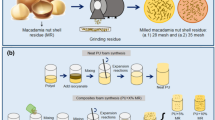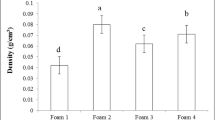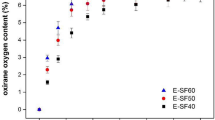Abstract
To decrease the usage of petroleum based materials, a kind of bio-resource based composite foams were developed with soy protein isolate (SPI) as reactive reinforcing filler in castor oil based polyurethane foams (PUF) prepared by self-rising method using water as a blowing agent. The resulting composite foams were evaluated for their morphology, density, mechanical and biodegradation properties, etc. Fourier transform infrared spectroscopy study exhibited characteristic peaks for SPI and PUF and indicated that the amino groups and hydroxyl groups on SPI reacted with polyphenyl polymethylene polyisocyanates (PAPI) to increase the crosslinking degrees of the composite foams. Densities of the resultant composites were found to increase with increasing SPI content. Mechanical properties of the samples were improved with the increase of SPI content. The compost tests further proved that the composite PUF had better biodegradability than neat PUF. Therefore, this research has provided a simple method of preparing the bio-resource based polyurethane foams, while exploring the potential of using SPI in polyurethane foam applications.









Similar content being viewed by others
References
Gupta RK, Ionescu M, Radojcic D, Wan X, Petrovic ZS (2014) Novel renewable polyols based on limonene for rigid polyurethane foams. J Environ Polym Degr 22(3):304–309
Desroches M, Escouvois M, Auvergne R, Caillol S, Boutevin B (2012) From vegetable oils to polyurethanes: synthetic routes to polyols and main industrial products. Polym Rev 52(1):38–79
Babb DA (2012) Polyurethanes from renewable resources. Advances in polymer. Science 245:315–360
[4] Duan J, Reddy K O, Ashok B, Cai J, Zhang L, Rajulu A V (2016) Effects of spent tea leaf powder on the properties and functions of cellulose green composite films. J Environ Chem Eng 4(1):440–448
Li Y (2011) Development of polyurethane foam and its potential within the biofuels market. Biofuels 2(4):357–359
Xu J, Jiang J, Hse C, Shupe TF (2012) Renewable chemical feedstocks from integrated liquefaction processing of lignocellulosic materials using microwave energy. Green Chem 14(10):2821–2830
Campanella A, Bonnaillie LM, Wool RP (2009) Polyurethane foams from soy oil-based polyols. J Appl Polym Sci 112(4):2567–2578
Moghadam PN, Yarmohamadi M, Hasanzadeh R, Nuri S (2016) Preparation of polyurethane wood adhesives by polyols for mulated with polyester polyols based on castor oil. Int J Adhes Adhes 68:273–282
Mutlu H, MeierM AR (2010) Castor oil as a renewable resource for the chemical industry. Eur J Lipid Sci Technol 112(1):10–30
Cordero AI, Amalvy JI, Fortunati E, Kenny JM, Chiacchiarelli LM (2015) The role of nanocrystalline cellulose on the microstructure of foamed castor-oil polyurethane nanocomposites. Carbohydr Polym 134:110–118
Zhang L, Zhang M, Zhou Y, Hu L (2013) The study of mechanical behavior and flame retardancy of castor oil phosphate-based rigid polyurethane foam composites containing expanded graphite and triethyl phosphate. Polym Degrad Stab 98(12):2784–2794
Luo Z, Shi Y, Zhao D, He M (2011) Synthesis of epoxidatied castor oil and its effect on the properties of waterborne polyurethane. Proced Eng 18:37–42
Alfani R, Iannace S, Nicolais L (1998) Synthesis and characterization of starch-based polyurethane foams. J Appl Polym Sci 68(5):739–745
Yoshioka M, Nishio Y, Saito D, Ohashi H, Hashimoto M, Shiraishi N (2013) Synthesis of biopolyols by mild oxypropylation of liquefied starch and its application to polyurethane rigid foams. J Appl Polym Sci 130(1):622–630
Barikani M, Mohammadi M (2007) Synthesis and characterization of starch-modified polyurethane. Carbohydr Polym 68(4):773–780
Kwon OJ, Yang SR, Kim DH, Park JS (2007) Characterization of polyurethane foam prepared by using starch as polyol. J Appl Polym Sci 103(3):1544–1553
Kim DH, Kwon OJ, Yang SR, Park, J S, Chun BC (2007) Structural, thermal, and mechanical properties of polyurethane foams prepared with starch as the main component of polyols. Fibers Polym 8(2):155–162
Chang LC, Xue Y, Hsieh FH (2001) Dynamic-mechanical study of water-blown rigid polyurethane foams with and without soy flour. J Appl Polym Sci 81(8):2027–2035
Luo X, Mohanty A, Misra M (2013) Lignin as a reactive reinforcing filler for water-blown rigid biofoam composites from soy oil-based polyurethane. Ind Crops Prod 47:13–19
Dash S, Swain S K (2013) Effect of nanoboron nitride on the physical and chemical properties of soy protein. Compos Sci Technol 84:39–43
Friesen K, Chang C, Nickerson M (2015) Incorporation of phenolic compounds, rutin and epicatechin, into soy protein isolate films: mechanical, barrier and cross-linking properties. Food Chem 172:18–23
Koshy RR, Mary SK, Thomas S, Pothan LA (2015) Environment friendly green composites based on soy protein isolate-A review. Food Hydrocoll 50:174–192
Routray M, Rout SN, Mohanty GC, Nayak PL (2013) Preparation and characterization of soy protein isolate films processed by compression and casting. J Chem Pharm Res 5(11):752–761
Silva SS, Oliveira JM, Benesch J, Caridade SG, Mano JF, Reis RR (2013) Hybrid biodegradable membranes of silane-treated chitosan/soy protein for biomedical applications. J Bioact Compat Polym 28(4):385–397
Tian H, Wu W, Guo G, Gaolun, B, Jia Q, Xiang A (2012) Microstructure and properties of glycerol plasticized soy protein plastics containing castor oil. J Food Eng 109(3):496–500
Ji J, Li B, Zhong WH (2011) An ultraelastic poly (ethylene oxide)/soy protein film with fully amorphous structure. Macromolecules 45(1):602–606
Fang QH, Zhou D, Han WC, Gao Y, Wang N, Yang F (2012) Preparation of soy protein isolate modified by glutaric dialdehyde and its application in rubber composite. Key Eng Mater Trans Tech Publ 501:208–214
Kumar R, Zhang L (2009) Soy protein films with the hydrophobic surface created through non-covalent interactions. Ind Crops Prod 29(2): 485–494.
Guo G, Zhang C, Du Z, Zou W, Li H (2015) Structure and properties of poly (vinyl alcohol)/soy protein isolate blend film fabricated through melt processing. J Environ Polym Degr 23(2):183–189
Guo G, Zhang C, Du Z, Zou W, Tian H, Xiang A, Li H (2015) Structure and property of biodegradable soy protein isolate/PBAT blends. Ind Crops Prod 74:731–736
Jong L (2015) Influence of protein hydrolysis on the mechanical properties of natural rubber composites reinforced with soy protein particles. Ind Crops Prod 65:102–109
Wang HJ, Rong MZ, Zhang MQ, Hu J, Chen HW, Czigany T (2008) Biodegradable foam plastics based on castor oil. Biomacromolecules 9(2):615–623
Shogren RL, Petrovic Z, Liu Z, Erhan SZ (2004) Biodegradation behavior of some vegetable oil-based polymers. J Environ Polym Degr 12(3):173–178
Acknowledgements
This work was supported by the National Natural Science Foundation of China (51373004 and 51203004), Beijing Top Young Innovative Talents Program (2014000026833ZK13), Open Funding of Key Laboratory for Solid Waste Management and Environment Safety (Tsinghua University), Ministry of Education of China (SWMES 2015-02).
Author information
Authors and Affiliations
Corresponding author
Rights and permissions
About this article
Cite this article
Zhang, S., Xiang, A., Tian, H. et al. Water-Blown Castor Oil-Based Polyurethane Foams with Soy Protein as a Reactive Reinforcing Filler. J Polym Environ 26, 15–22 (2018). https://doi.org/10.1007/s10924-016-0914-0
Published:
Issue Date:
DOI: https://doi.org/10.1007/s10924-016-0914-0




